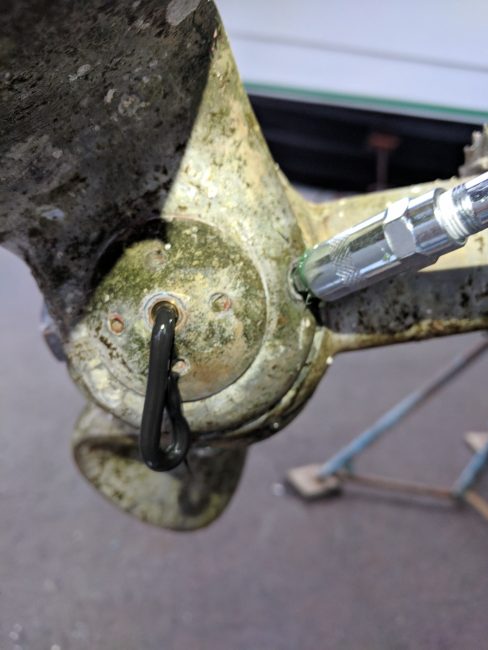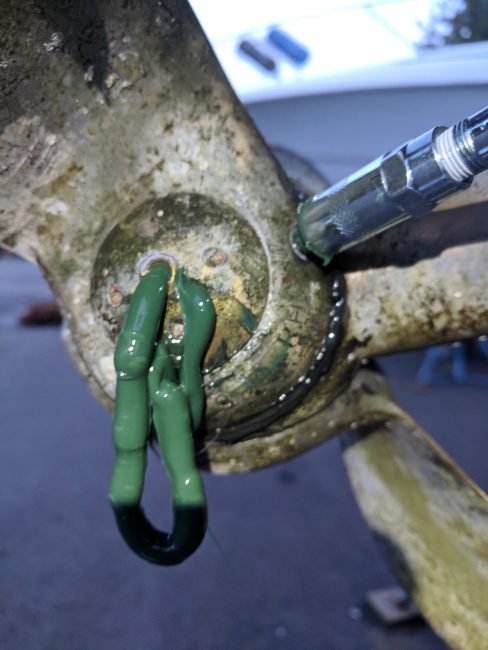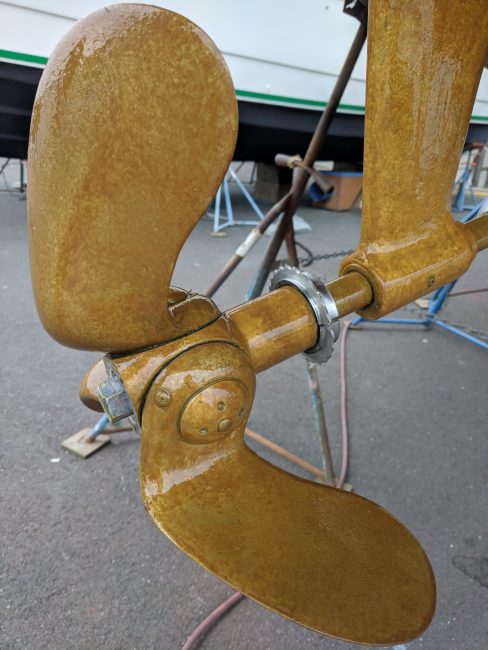This post is a bit more technical and more for other sailors interested in propellers. Hopefully it may come in handy someday for those with AutoProps, because there isn’t a whole lot of community info on them that I could find.
We have an AutoProp propeller on our boat. It’s like a MaxProp, which is also a feathering propeller, except that the AutoProp is also dynamically pitching – instead of a fixed, preset pitch, it changes its pitch to match operating conditions.
It’s really a very clever piece of engineering – dynamic pitch means that in theory it’s always at the optimal pitch for our speed and engine power. This mainly applies when motor-sailing (which is pretty common in the Northwest) – our sails can contribute some speed while the AutoProp contributes some as well, but allows our engine to work less hard – meaning lower engine RPMs, saving on fuel but getting the same power as a higher RPM.


Do We Need a Rebuild?
But one downside to this engineering marvel is it’s a bit more complicated – the ball bearings in the blades require servicing, and the prop may need to be rebuilt every 10 years or so. This is because the bearings wear and the groove they run in may actually deteriorate. I emailed Brunton’s, the UK manufacturer of the prop, telling them I had records that a prior owner had done a rebuild in 2008, and the Brunton’s owner told me it was probably due again.
Doing a rebuild though means pulling the prop off and shipping it to King Propulsion on the east coast. I called a local prop shop (Kruger & Sons) that the yard recommended, but they said they could probably figure it out but had never worked on an AutoProp before. This was a daunting aspect of our haul-out because it sounded technically complex and had the most potential to delay the haul-out (which we didn’t want since we live aboard).
I talked extensively with the owner of King Propulsion (Rod Sampson) and he was probably the most helpful anyone in the marine service has ever been in my experience. He sent me a grease zerk fitting when I had trouble finding one locally (the AutoProp requires a 5mm zerk fitting, and metric sizes are uncommon in the US – the local shops that did have them didn’t have smaller than 6mm).
In the end I decided just to inspect and regrease the blades. I found an AutoProp service manual which said it should be rebuilt every 1000 engine hours, and we’re not quite there yet (about 800 since 2008). We’ll send it to King Propulsion next year for a rebuild.
Regreasing an AutoProp
Regreasing is an annual maintenance recommendation by the manufacturer, but how many boaters really follow manufacturer recommendations to the letter? Our prop hadn’t been regreased in probably 8 years, maybe 10. So I was a bit afraid of what I’d find.
Upon haul-out, all blades turned in my hand, but one was a little rough – it would stick in a couple spots, and wouldn’t fall by the force of gravity, which is the test to determine if your AutoProp is feathering perfectly. The other two blades did that fine (a slow gravity fall is okay – they don’t drop super quickly).
So I regreased them with the zerc fitting Rod had sent me. I’ve never used a grease gun before, and man I have to say it’s pretty fun! Way easier than I expected, and forcing out all that old dirty grease with fresh new grease was pretty satisfying. Later I used the grease gun on our windlass, which also had been neglected in the grease regimen. I hate to buy tools that we’ll only use once a year, but a grease gun is pretty cheap.

Dirty grease coming out of the cap fitting
I pushed Sierra marine lithium grease through each blade, doing a lot extra on the sticky blade – for that one I did four rounds, rotating the blade during and in between each round. Some water ejected from the hub on each blade (this is normal), but the sticky blade ejected a bit more dirty grease than the other two did. After regreasing it felt better, but still doesn’t gravity fall of its own accord.

Clean, fresh grease coming out of the cap fitting after injecting a bunch through the hub fitting
When we have a longer haul-out planned I’ll be sending the AutoProp to King Propulsion for a rebuild.
Antifouling
I also debated what to do about antifouling for the prop and prop shaft. Two years ago we used a zinc coat (3 coats from a spray can) and it only lasted about 6 months. It’s cheap, but the prep still takes a couple hours. This year I had the yard do PropSpeed, because it has a reputation of being the best and they said it should last 2 years.

AutoProp Zinc / Aluminum Anodes
The only other annoying thing about the AutoProp is its anode falls off early and easily. It’s a proprietary anode, so you can’t order a generic anode, you have to order the AutoProp anodes. And they don’t have a great deal of material on them, and often spin off the prop early because the metal around their securing bolts wastes away early.

AutoProp before cleaning, right after haul. You can see the remains of the zinc on the end.
So you end up having to replace it every 4-6 months, which is a pain in the PNW because unless you’re really hardcore you probably don’t want to be in the water in the winter – so you’re hiring a diver for $75-100. And if you do dive in the frigid water yourself, like I did last fall – you’ll find the nylon screws provided with the AutoProp zincs easily break off when being removed. Then you have a much bigger problem of half a screw being embedded in the prop and have to just use 2 screws till your next haul-out (or get someone willing to do an underwater extraction).
To make a long story short, I made 3 changes to try to alleviate these problems:
- Switched to aluminum anodes. It sounds like they might last longer, and anyway Washington is recommending aluminum now because it’s supposed to be better on the environment.
- Painted around the bolt holes of the anode with transducer antifouling paint. This is a common recommendation online. Any kind of paint would probably work, but transducer paint is what I had easily on hand and last year I had tried nail polish but it hadn’t seemed to last long. I also smeared Lanocote around the bolts.
- Used SS bolts with allen heads. These are 6mm bolts by 20mm length (bought from Tacoma Screw because Fisheries was all out of metric bolts). These won’t break off and I was able to use them to clean out the threads in the prop as well – dirty threads are why the nylon screws got stuck and broke.
Allen heads aren’t essential, but are nice for easy removal underwater.
Although cleaning the threads might have fixed the nylon bolt problem, my feeling is it’s a prop – it’s underwater, so it’s always getting dirty and fouled by marine growth, so counting on the threads to stay perfectly clean is a losing bet.
I think the reason they provide nylon threads is to avoid dissimilar metal corrosion, but every other prop shaft anode in the world uses SS bolts, and dissimilar metal corrosion works pretty slowly, so I’m suspecting it’s not a problem. Plus LanoCote, the best stuff ever.

I’m looking to replace my 2 blade fixed prop with either an AutoProp or other 3 blade solution. My main two goals is to get some additional speed while under higher RPMs, and to have a more efficient cruising profile under motor alone.
The AutoProp is really attractive to me because of it’s auto pitch design – changing based on the forces around it to be as efficient as it possibly can be, rather than the fixed pitches even on other folding models.
It might not be something you can comment on, but do you have any sense for how more efficient it is versus a standard folding prop or fixed prop?
Would you install an AutoProp on a future boat, or would you consider other technologies?
I’m not sure I’d necessarily choose an AutoProp again. It’s less common in the US than MaxProp and therefore a bit harder to get service/parts for. I think any feathering or folding 3 blade prop will be much better than a fixed 2 blade prop – so I would go based on other factors like reviews, cost, ease of selection (correct sizing).
Interesting, thanks for the feedback. MaxProp are definitely more prevalent, but they don’t seem to have the same power curve through RPM in terms of their pitch auto-adjusting at lower RPMs. That seems to be pretty unique to AutoProp, and essentially removes the need to adjust things at any point, which is sort of nice.
I have queries out to both for cost and details for my boat. Hopefully one will pop up as supremely better than another!
I have a Brunston Auto prop on my catalina 440 DS . It is a great prop would have one again,great for manovering and drops the RPM by about 400 RPM for the same speed as standard prop ,
Brunton Autoprop – Lost a Prop x2
I have one fitted to my 42 ft Adams cruising yacht and three years ago one of the three blade dropped off. It was because the securing nut came loose and disappeared along with the blade. I returned the prop to Bruntons to have them install a new blade and balance the propeller. They did this at some cost.
Recently another blade has dropped off. I have again returned the Autoprop to Bruntons UK. What should I do? Has anyone had a similar experience?
I have photos. Bruntons response to me is unprintable
I just hauled the boat, purchased the service kit, serviced the prop, launch the boat, lost a blade and crashed into a dock when there was no reverse. Did you ever find the reason for this?
I have had a very unhappy relationship with Bruntons and the MD in particular. On the first occasion when the blade came off after quite a long sea voyage I put it down to just bad luck. I did bend my 1.5 inch short shaft which cost me quite a bit of extra money. I then returned the propeller to Brunton for a new blade, service and balancing. I again did a long sea voyage 2,000 nm but inspected the prop and greased it half way. On returning to Australia for the second time a blade came off. On request from the MD I returned the prop to Bruntons. Under Australian consumer law it is very clear that there appears to be a fault in design and the prop is not “fit for purpose” I pointed this out to the MD and suggested a way forward. For six months he refused to communicate with me or return the prop as if holding the prop would destroy the evidence. When the legal people got involved Bruntons immediately returned the still damaged prop complete disassembled to me in Australia. What my next step will be is to gather people like yourself and I know three others to take action as a group against them to replace our propellers with others. My insurance company withdrew cover because of this incident and potential damage that may occur if it refitted the prop. Harry Watson Smith
The Autoprop was a complete waste of money, time and after two years I removed the failed prop from my boat. Any fouling on this prop changes the angle of incidence and the blades are no longer at the same angle and severe vibration results. My friends boat with an Autoprop vibrated so badly that his strut broke and his boat had to be pulled to be repaired. The bearings also failed on my prop and locked up, so the prop was unusable and luckily I was able to get a standard prop and carry on.
There are many well proven adjusting props on the market and the Autoprop is not one. The prop should not be on any cruising boat….
Dealing with the US dealer was a joke and after all my problems they said” you bought it and it is not returnable”….
Please avoid this prop at all costs!
Hi Steve – yikes, that doesn’t sound good! We never experienced an issue with fouling causing severe vibration, or bearings failing. That’s surprising.
I am sorry to hear these sad stories of lost Autoprop blades. With all due respect to the intentions of the mechanics or owners who fitted the blades there is no doubt that the cause is always improper or inadequate fitting of the bearing locknuts and their lock-tab screw device.
Without wanting to jinx myself (!), I can say I have had an H6 23 inch Autoprop driven by a 110HP Volvo Penta since 29 January 2001. That’s almost 20 years. Since that time it has been in use for about 6500 hours,
It has circumnavigated the globe and done other cruising miles equal to twice that distance, still with the original three blades. In that time I have replaced all the bearings and seals twice and it gets greased once a year.
In my experience it is an excellent propeller that does everything that Bruntons claim and no, I have no connection with them. With the exception of the lip-seals I buy all my replacement parts from bearing companies.
It is not really valid to compare an Autoprop with a feathering prop, such as a MaxProp, because all feathering props have flat blades and hence are very inefficient propellers. If you want a good efficient low sailing drag prop get a folding propeller with properly shaped blades, and the more blades the better. It won’t cost much less than Autoprop however and will not be great for motor sailing.
There is no doubt that the prop works but in my case the prop lost a blade. It was sent back to Bruntons for a new blade and complete service. It was reinstalled and after just one 2000 nm voyage it lost a blade. The unit was again returned to the manufacturer. On this occasion they did not return email and when they did they implied it was damaged when it at arrived but could not provide an photos. Long delays and no progress. With the threat of legal action as not fit for purpose they responded and returned the unit in pieces but still missing a blade.
My insurance company will not insure my vessel with this style of propeller due to fear that a blade could damage the hull as it is dropped as it did in the last instance.
I requested a replacement propeller from Bruntons but they refused.
This is not a company one can trust or put your vessel and life dependent on your products. Poor customer service.
I have known the MD of Bruntons since we were both teenagers 60 years ago. he is one of the nicest guys in our club. He started at Bruntons as an aprentice & worked his way to MD & retires this year. I will be seeing hin today. If he was in any way rude to a customer then that customer had obviously done something very wrong to upset him in the first place.
Things do break on many products & something could have caused the prop blade to come off ie previous impact.I would suggest that those reading the complaint ignore it.
I have a Brunton Autoprop & find that in chop it “pulses” So when the boat hits a wave the boat stops, the prop feathers & drive stops. The prop then begins to bite & the boat begins to move forward again. But hits another wave & stops again. The result being that in chop one has to rev faster 7 use more fuel to make progress. However, when motorsailing it is brilliant as even on very low revs the prop pitches & gives drive. So it is horses for courses. Fuel consumption is no better than a fixed prop.